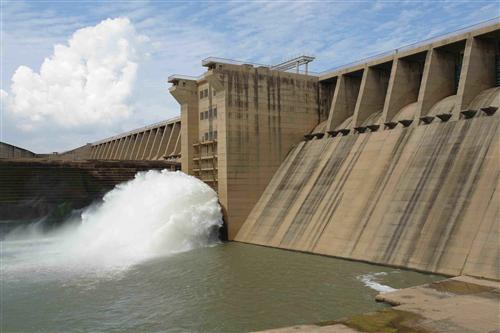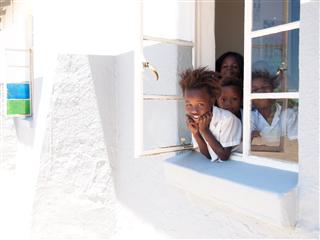Basic data
Despite South Africa’s past political turmoil it has risen to be the African continent’s superpower. An ethnically diverse country with 11 official languages recognized in the Constitution, South Africa’s population currently stands at approximately 50 million. Black Africans are in the majority at about 80%. South Africa is unique in that it has three capital cities: Pretoria (administrative capital), Bloemfontain (judicial capital) and Cape Town (legislative capital) The population growth rate was 0,5% in 2011, the median age 25, which makes South Africa a fairly young country by world standards. The HIV prevalence for adults was 17,8% in 2009. The Human Development Index (HDI) for South Africa was 0,619 in 2011, ranking it 123rd out of 187 countries with data (UNDP HDR 2011).
South Africa shares four international river basins: Incomati, Limpopo, Maputo, and Orange-Senqu. Its largest city, Johannesburg, lies close to the boundary of the Orange-Senqu River basin with the Limpopo River basin.
The Economic Powerhouse of Africa
South Africa is considered a middle income country by the World Bank; however, development is concentrated in four main areas: Cape Town, Johannesburg/Pretoria, Durban and Port Elizabeth. Beyond these economic centres, economic development is limited and poverty is prevalent.
Mining has been the major driving force behind the development of South Africa’s economy to the most advanced and richest in Africa. Although gold mining has strongly declined during the past three decades, South Africa is still the second largest gold producer of the world (after China). The country is the world’s largest producer of several other metals, especially chrome, manganese and platinum. It is the world’s third largest coal producer. Today mining accounts for about 3% of the GDP, down from 14% in the 1980s.
South Africa has a big commercial farming sector, which provides about 8% of the contry’s exports, 2,5% of the GDP and 10% of formal employment. South Africa is the eighth largest wine producer worldwide; besides that it mainly exports sugar, grapes, citrus and vegetable. The production of maize amounts to about nine million tonnes per year, with more than seven million tonnes cosumed locally. South Africa also produces a lot of livestock, with 85% of the meat consumed locally. – Commercial agriculture faces increasing challenges: foreign competition, crime and shortage of water.
South Africa’s manufacturing sector is relatively small, providing about 13% of jobs and 15% of GDP. Most important is the automotive industry. It produces more than half a million vehicles per year, contributes 7,5% to the country’s GDP and accounts for 10% of its manufacturing exports.
In the services sector telecommunication is rapidly expanding. Apart from that, South Africa is a very popular tourist destination – with nearly a million arrivals per month.
Big challenges to the economy include:
-
A chronic shortage of power, which the state-owned power supplier Eskom is meeting with the current construction of the two largest coal-fired power stations in the world
-
frequent strikes by unsatisfied and politically highly mobilized workers
-
a scarcity of skilled labour due to brain drain (nearly two million professionals have left the country since 1994) and problems in the education sector.
Social Tensions
While South Africa is a middle income country, it has serious social inequalities. The country is ranked in the top ten countries in the world for income inequality. During recent years, millions of formerly disadvantaged black people have entered the middle-class, or have even become wealthy. As a result, inter-race inequality is shrinking, but intra-race inequality is rapidly growing.
Throughout South Africa, parts of society enjoy socio-economic conditions equivalent to the wealthy in the developed world; while others experience extreme deprivation and exclusion, leading to poverty comparable with that of the least-developed countries. Poverty is most profound in rural areas. Almost 50% of the non-white population lives below the national poverty line, with many households still not receiving satisfactory access to clean water, energy, health and education. All of these factors combined influence South Africa’s high crime rate.
There are a number of socio-economic issues in South Africa that affect children in particular (UNICEF 2009), including:
-
Poverty and HIV/AIDS remain the two key, inter-linked drivers of maternal and child mortality, as well as gender-based and child-targeting violence and abuse in South Africa.
-
A significant portion of the country still depends on less than US$1 per day, with children representing a substantial part of that population.
-
South Africa is the country hardest hit by HIV/AIDS worldwide. An estimated 5,5 million people in the country are currently living with HIV. Women – in particular those in child-bearing age – are the worst-affected.
-
The HIV/AIDS crisis has compounded the risks faced by children, and swelled the number of those at risk. The total number of orphans was estimated at 2,5 million in 2005. It is expected to double by 2015 due to high (and still increasing) maternal mortality, among other factors. Orphans are more vulnerable to violence and abuse than children living with parents and caregivers.
-
South Africa has one of the world’s highest crime rates, with children and women victimised and with a significant proportion of the cases involving murder, rape and common assault.

The Vaal Dam, supplies water to Gauteng Province.
Source:Vogel 2009
( click to enlarge )
Strategies to Reduce Poverty
Since the end of apartheid, South Africa has implemented some 30 000 government-funded projects for poverty reduction, and has created a Constitution and Bill of Rights, including rights to basic services. This Bill of Rights mandates access to sufficient potable water, food and health services. Despite these accomplishments, nearly half of South Africa’s population lives below the poverty line and unemployment rates remain high.
In order to address the challenges to reduce poverty, the South African Government has initiated the Accelerated and Shared Growth Initiative – South Africa (ASGISA). The goal of this programme is to halve the unemployment rate to 15% and reduce the poverty rate to less than one-sixth of households by 2014. In addition to these economic targets, its other goals are to improve the environment and to increase opportunities for more labour-absorbing market activities. The ASGISA task team identified several constraints:
-
Volatility and level of the currency
-
The cost, efficiency and capacity of the national logistics system
-
Shortage of suitably skilled labour, amplified by the impact of apartheid spatial patterns on the cost of labour
-
Barriers to entry, limits to competition and limited new investment opportunities
-
Regulatory environment and the burden on small and medium businesses
-
Deficiencies in state organisation, capacity and leadership
ASGISA also came up with a set of priorities to overcome the identified constraints:
-
Infrastructure programmes
-
Sector investment (or industrial) strategies
-
Skills and educations initiatives
-
Second economy initiatives
-
Macro-economic issues
-
Public administration issues
To find out about South Africa's progress towards achieving its development goals, please refer to the Human Development Indicators pages of this theme.
 Educating youth is one of the key areas that will contribute to poverty reduction. Source:Kruchem 2011 ( click to enlarge ) |
